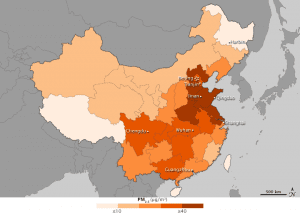
This map, which shows annual exposure between 2008-2010, indicates most areas had PM2.5 levels that exceeded World Health Organization guidelines (10 micrograms per cubic meter).
Many types of aerosol particles circulate in the atmosphere, but one of the most damaging to human health is known as PM2.5, a technical term for microscopic bits of matter less than 2.5 microns in diameter (one-thirtieth) the width of a human hair). These small pollutants, which come mostly from burning fossil fuels and biomass, can lodge deep in the lungs, where they exacerbate a variety of respiratory and cardiovascular diseases.
Satellites offer a perspective on PM2.5 that is particularly useful when ground instruments are unavailable or offer limited information. With that in mind, researchers at Columbia University's Earth Institute and Batelle Memorial Institute have developed maps based on satellite data that depict annual PM2.5 exposure in all of China's provinces.
Areas surrounding Beijing and to the south along the coast, which fall in China's industrial heartland, had the most pollution. In many cases, annual exposure was above 40 micrograms per cubic meter. Other provinces in eastern and south central China had pollution levels above 30 micrograms per cubic meter. For comparison, the New York, Chicago and Los Angeles metro areas have PM2.5 levels that average between 10 and 20 micrograms per cubic meter.

